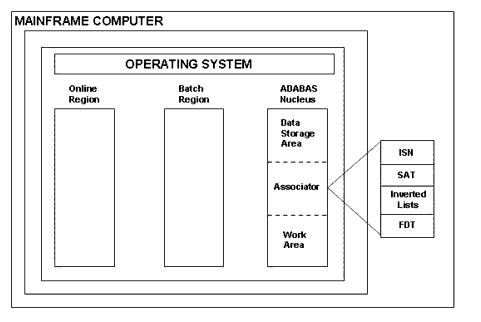
ADABAS is a field-oriented DBMS. Data retrievals and updates are performed on a field-by-field basis.
Since ADABAS data retrieval occurs at the field level rather than at the record level, your applications may be designed without consideration for the physical organization and maintenance of the record. Data is accessed in a variety of ways (in physical sequence, in logical sequence, or by Internal Sequence Numbers), thereby enabling you to tailor the access to address your specific needs.
The ADABAS DBMS consists of several components. The following is an illustration of the ADABAS environment.

The following are the components of the ADABAS environment shown in Figure 3-1:
Operating System |
Is a set of programs (software) that control the operation of the computer (hardware). |
Online Region |
Is part of the Dynamic Area of the computer. It is the section in which multiple jobs execute simultaneously. Online Region is also known as the Foreground Region (applies only to TSO). |
Batch Region |
Is also part of the Dynamic Area of the computer. Jobs become a series of commands that are grouped together and processed in batches (applies only to batch jobs). |
Data Storage Area |
Contains the actual data. The data is stored in compressed form. |
Associator |
Stores relationships about the data. It contains the following components:
|
Work Area |
Is a "scratch pad" used by ADABAS to build ISN lists and to sort and store records that your program requires. |
The Multi-Programming Module (MPM), the cornerstone of the ADABAS Nucleus, contains the logic that enables multiple programs, both batch and online, to access ADABAS databases simultaneously.
Each database has its own data storage area, associator, and work area, in addition to its own unique database number.
| Information Builders |